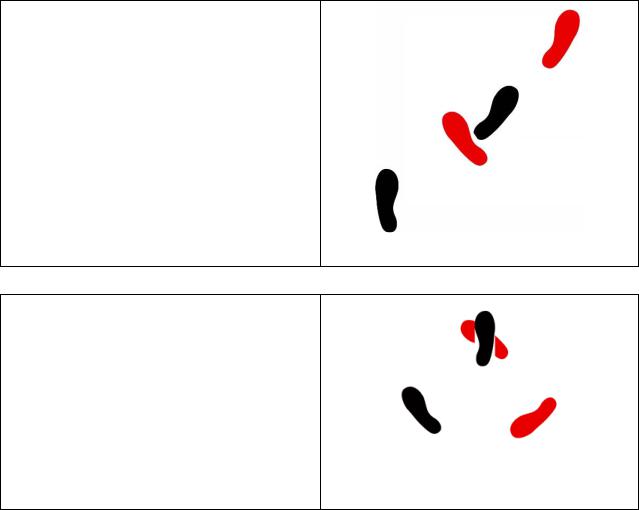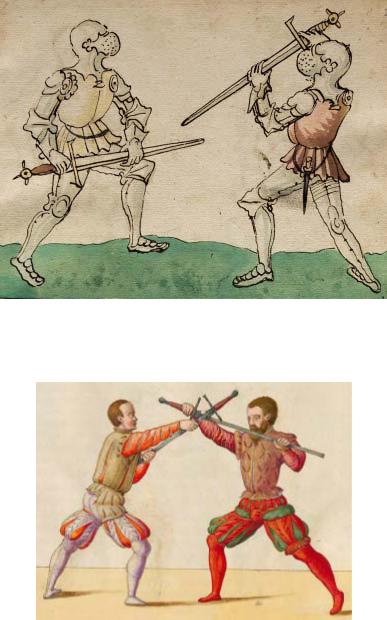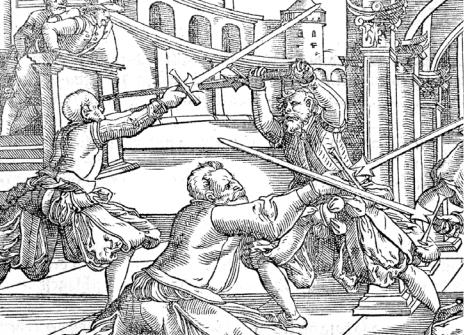
longsword_handout
.pdf
Gather Step
Stand with your right foot forward and your left foot back. Gather your rear foot toward your forward foot, then step forward on the forward foot to come back into your initial stance. This is a gather step on the right foot.
From black to red is a gather step on the right
Back Step
Stand with your right foot forward and your left foot back. Step with your left foot backwards behind your right. This is a backstep on the left foot.
From red to black is a back-step on the L foot
11

7. Techniques from Armored Combat
Halfsword Guards
The Low and High Guards at Halfsword. The same guards are also used in unarmored combat.
Murder-Blow (Mortschlag)
The figure on the left is delivering the Murder-Blow. This is easiest to set up by starting in a halfsword guard.
12
8. Basic Drills
8.1 Improvised Katas
Practice randomly running through all the techniques you know (guards, cuts, etc.). Use this document to remind yourself of your repertoire of techniques. This drill can be done solo, or in pairs or groups, with people taking turns leading. It is an excellent warmup drill.
Simple version: Use only passing steps or only triangle steps
Advanced version: Mix up the stepping; you can also choose to cut through or end the cuts in Longpoint
8.2 The Straight Cuts Drill [Meyer 1570]
Start in Fool with your right foot back.
Lift your sword into High Guard, passing through Hanging Point with crossed hands, blade to the left, as you bring the sword up.
Deliver a Scalp Cut, passing forward on your right foot, ending in Fool.
Lift your sword into High Guard, passing through Hanging Point with uncrossed hands, blade to the right, as you bring the sword up.
Deliver a Scalp Cut, passing forward on your left foot, ending in Fool.
Repeat this an equal number of times on the right and left sides, then do it stepping backwards on each cut.
Repeat delivering Wrath, Middle, and Low Cuts. Start each series from the position where the cut ends, as you began the Scalp Cut series from Fool. Both forward and backwards, the cut will come from the side that starts with the foot back.
Variants:
1.End the cuts in Longpoint
2.Do the drill with triangle steps
3.Deliver a different cut each time
13
4.Randomize the forward and backward stepping, also throwing in triangle steps
5.Mix up these variants
Paired version: Attacker ends the cuts in Longpoint, defender catches the cuts by winding into Ox or Plow—catch Scalp and Wrath Cuts with Ox, catch Middle and Low Cuts with Plow.
8.3 The Two and Four Quarters Drill [Meyer 1570]
Two Quarters—Solo Version
Start in Longpoint with your right foot back (you are out of range of the opponent at this stage).
1.Let your blade drop to your left side, and bring it around to deliver a right Wrath Cut, passing forward on your right foot, and ending in Longpoint. (The passing step brings you into range.)
2.Deliver a left Low Cut, doing a triangle step on your left foot, ending in Hanging Point. (The triangle step moves you around the opponent while maintaining distance.)
Deliver a right Wrath Cut, passing back on your left foot, cutting all the way through to Change, and recover to Ox. (This is called cutting away, and serves to protect you as you move out of range.)
Variants:
1.Start the cuts in all four quarters of the opponent; each time, the second cut comes diagonally opposite the first. The basic version is R Wrath, L Low, so add R Low, L Wrath; L Wrath, R Low; L Low, R Wrath. You will need to alter the footwork accordingly.
2.Randomize where you deliver the first cut.
3.Cut all the way through with the first two cuts.
4.Start from Ox instead of Longpoint
Two Quarters—Paired Version
The attacker does the same as in the solo version. The defending sequence is as follows: Start in right Plow.
1.Triangle-step on the right foot, winding up into left Ox to catch the cut.
2.Triangle-step on the left foot, winding down into right Plow.
14

You can cut away when the attacker cuts away.
Similar defenses can be used against the variant attack sequences. Each time, the defender triangle-steps away from the cut, catching it by winding into Ox for Wrath Cuts, Plow for Low Cuts.
Four Quarters—Solo Version
Instead of doing just 2 cuts, the attacker delivers a cut to all 4 quarters of the opponent, as follows:
Start out of range in Longpoint with your right foot back.
1.Deliver a right Wrath Cut, passing forward on your right foot.
2.Deliver a left Low Cut, triangle-stepping on your left foot.
3.Deliver a right Low Cut, triangle-stepping on your right foot.
4.Deliver a left Wrath Cut, triangle-stepping on your left foot.
Cut away with a Wrath Cut, passing back on your left foot, and recover to Ox.
Variants:
1. Repeat this pattern beginning in a different quarter (following the numbers as in this diagram).
In the first sequence, the initial attack is from the upper right quarter (the outermost “1” above), then lower left (2), lower right (3), upper left (4). The second series begins with 1 in the lower right, 2 in the upper left, and so on.
2.Cut all the way through with the cuts.
3.Deliver the attacks as Thwart Cuts
15
Four Quarters—Paired Version
The attacker does the same as in the solo version. The defending sequence is as follows:
Start in right Plow.
1.Triangle-step on the right foot, winding up into left Ox to catch the cut.
2.Triangle-step on the left foot, winding down into right Plow.
3.Triangle-step on the right foot, winding across into left Plow.
4.Triangle-step on the left foot, winding up into right Ox.
You can cut away as the attacker cuts away.
Similar sequences of defenses can be used against each pattern of attacks.
16

9. The Five Master Cuts
Wrath Cut (Zornhaw)
Described in Section 4. The Wrath Cut is the simplest and most powerful cut, and can also be used as a defense against most cuts.
Scalp Cut (Scheitelhaw)
Described in Section 4. The Scalper is a very quick and long cut that goes straight for the head. It is the classic response to an opponent in Fool.
Thwart Cut (Zwerchhaw)
Start in right Ox and helicopter your blade around your head to end up in left Ox; repeat in the other direction. This is a pair of Thwart Cuts. The Thwart Cut protects the head while threatening the opponent; it is the classic response to an opponent in High Guard.
The figure on the R is executing a Thwart Cut against a High Cut.
Squinting Cut (Schielhaw)
Start in Ox; come up into High Guard as for a Scalp Cut, but as the blade reaches vertical, flip it around to lead the cut with the short edge. The final position of the cut will be Ox on the
17

opposite side (depending on the tactical situation, the hands can drop down into Plow). The Squinting Cut threatens the opponent while protecting one side of the body; it is the classic response to an opponent in Plow.
The large figure on the L is executing a Squinting Cut against a High Cut
Crooked Cut (Krumphaw)
Start in Crossed Guard; flip the blade across in front of you propeller-wise to Crossed Guard on the opposite side, stepping with the cut.
Crossed Guard; it should be done with the thumb grip.
18

This is the most defensive cut, as it clears the space between the combatants, but it does not defend and attack at the same time, unless it is used against the opponent’s arms. It is the classic response to an opponent in Ox.
The figure on the R is executing a Crooked Cut against a Middle or Low Cut.
9.1 The Master Cuts Drill
Do each Master Cut forward and back as in the Straight Cuts drill (Section 8.2). Variants 2-5 will also work.
19

10. Sample Encounter: The Double-Thwart [Meyer 26r]
A |
B |
|
|
Start in Fool |
Start in right Change |
|
|
Come up into High for a Scalp Cut |
Sweep up to the left to set up a Thwart |
|
|
Deliver Scalp Cut, passing forward on the R |
Deliver a Thwart from the R, with a R triangle |
foot |
step |
|
|
To protect against the Thwart, the Scalper will |
Ideally, pull the Thwart before contact. |
have to fall on the middle of B’s blade. B now |
|
has the initiative, so A will act in response to |
|
B’s actions in the rest of the encounter. |
|
|
|
Block B’s Thwart with a L triangle step |
Deliver a Thwart from the L with a left triangle |
|
step |
|
|
|
Wrench A’s blade to your R |
|
|
Block B’s Thwart, stepping toward the L if |
Deliver another Thwart from the L1. The |
possible |
stepping for the wrench and Thwart can be |
|
either a gather step or back-step toward the L |
|
|
Cut away |
Open the distance with a Middle Cut from the |
|
R, passing back on the L foot |
|
|
|
Cut away |
|
|
1 Meyer actually calls for a short-edge cut with crossed arms. The L Thwart has crossed arms, but is done with the long edge.
20
